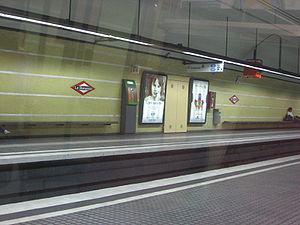
La Bonanova (Barcelona Metro)
Encyclopedia

Barcelona Metro
The Barcelona Metro , part of the public transportation system of Barcelona, Catalonia, is an extensive network of electrified railways that run underground in central Barcelona and above ground into the city's suburbs. Since July 31, 2010, Barcelona Metro system consists of 11 lines with 165...
, operated by FGC
Ferrocarrils de la Generalitat de Catalunya
Ferrocarrils de la Generalitat de Catalunya , or FGC, is a railway company which operates several unconnected lines in Catalonia, Spain....
. It was opened in 1952. It serves Barcelona Metro line 6
Barcelona Metro line 6
— Line 6, coloured navy blue, is the name of a metro-like commuter train service in Barcelona operated by FGC, and part of the ATM fare-integrated transport system. It links Plaça Catalunya, the city centre, with Sarrià-Sant Gervasi...
as well as the S5 and S55 suburban trains.
Located in the Sarrià-Sant Gervasi
Sarrià-Sant Gervasi
Sarrià-Sant Gervasi is one of the biggest districts of Barcelona, situated on the north-west of the city, surrounded by districts of Les Corts, Gràcia, Eixample i Horta-Guinardo, and by the villages of Sant Just, Sant Feliu, Molins de Rei and Sant Cugat...
district, it is situated under the Via Augusta at Carrer de Ganduxer. It has two accesses, one on either side of the Via Augusta, and three platforms (two side platforms for embarking and a central platform for alighting) in what is known as the "Barcelona solution
Spanish solution
The Spanish solution is a method of using two railway platforms, one on each side of the track, in order to speed up boarding and alighting from trains. Alighting passengers get off the train on one side and boarding passengers get on from the other...
."

